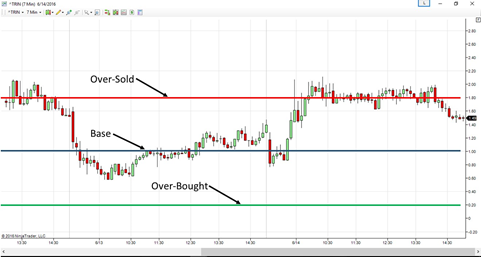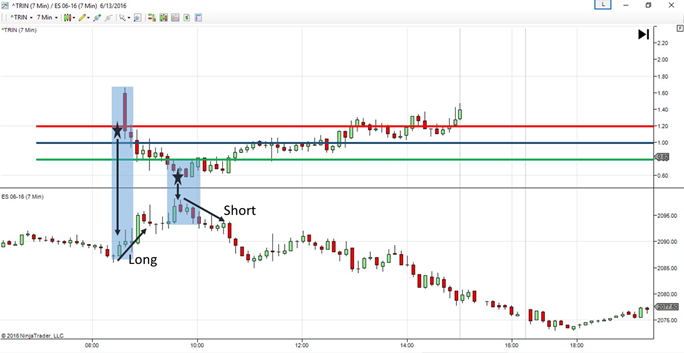
Using The TRIN To Spot A Winning Horse Before Making Your Trade
The ‘riders up’ call has been made and you can cut the air with a knife. Women surround you in stylish hats, mint juleps swirl everywhere you turn — and you could care less. It’s the Kentucky Derby and you have seconds left before placing your bet.
Deciding to bet with the ‘smart’ money, you decide you’re going to get a look at the contenders yourself. Trying to steal a last look at the horses as they leave the paddock. Forget the favorite, or the hype — this is your money on the line and you’re looking for a winner that’s ready to race.
In the derby of today’s market, the TRIN can be your key to spotting winning reversal points in overbought or oversold conditions. Like reading a horse before a race, it gives you a clear indication of when to make your move and when to steer clear.
An index that helps you spot winning reversals
If you’ve watched the coverage leading up to any of the three major derbies, you know there is no shortage of pronastication when it comes to picking winners. The talking heads aside, the seasoned or ‘smart’ money knows what to look for just by watching the horses warm up and then walk to the gate.
Everything, from the look in a horse’s eye, to the nature of their pace is monitored and analyzed. As the market is paraded out for any given period, you can turn to a simple indicator — right within your platform — to determine what type of trading conditions you’re dealing with.
The TRIN, or NYSE Traders Index (also known as the ARMS index) can provide a solid, leading glimpse into the daily direction of a market. More specifically it’s a calculation that gauges volume in the form of an advance and/or decline ratio.
With the base of the ratio being ‘1’, ratios less than one are considered bullish and ratios over one are considered bearish.
When the TRIN reaches extremes, you can use it as confirmation that a reversal is coming your way — allowing you to locate a trade you can lean on.
Extreme price conditions that you should watch for
There are some givens when reading a horse headed to the track for a race. If it has a healthy sheen to its coat — that’s good. Profuse sweating combined with erratic movements will tell you that the horse is overwhelmed and not ready to race — steer clear.

Unlike a racehorse, price behavior that pushes the limits is a good sign — and the TRIN will help you spot these extremes. For intraday trading, the TRIN can serve as confirmation that price is in fact reaching either overbought or oversold conditions.
Starting with the base of ‘1’, you’re simply looking for a ratio that’s over 1.8 for oversold conditions, and under .20 for overbought conditions. As you can see above, these conditions are easily tracked and charted. Knowing when pricing is reaching these extremes positions you to spot and trade for reversals.
Entering with two simple winning locations
The pros will tell you they can consistently pick horses that ‘show’ — or place first or second — in any given race. They’ll tell you it’s a ‘sense’ they have that can fully be put into words — a supernatural connection and ability.
You don’t need anything supernatural to use the TRIN when spotting reversals. Simply watch for the TRIN to exceed 1.2 and spot a reversal to go short. When it dips below .8 you have overbought conditions and a chance to go long.
Since the two are separate charts, you’ll need to set them up directly next to each other so that you can monitor both. With the TRIN set up next to the ES in our example below, you can see both a winning long and short trade, simply by watching this index.

When the TRIN was:
- Above 1.20: Price on the ES reversed and climbed for a solid long trade
- Below 0.8: Price reversed and went short with this oversold condition
The TRIN takes seconds to add to any chart and doesn’t cost a cent to use. A great way to spot winning reversals, without having to interpret the sweat patterns of price!
Avoiding bad bets by verifying conditions
There are those who claim that horses are smart enough to game the system and adopt behaviors that conceal their real readiness leading up to the race. However, they are found out in a matter of time as the pros learn to discern the underlying truth from the bravado.
It’s fair to point out that the TRIN is a separate, non-correlated index — not directly placed on your chart or instrument like an indicator. While the TRIN may be showing extremes, you may wonder how much they tie in to your particular market.
If you’re apprehensive about hanging your reversals on the movement of the TRIN, let it run alongside your chart for a full trading day. You’ll find more than a string of reversal points that not only go in your favor, but give you plenty of time to spot your location and prepare your entry. This gives you a chance to confirm with other methods that you may be running directly on your chart, like the MFI (money flow index). This will allow you to verify overbought and oversold conditions as you integrate this into your trading strategy.
Succeed with an index that picks winners alongside your chart
A prize horse with a relaxed gait and an eager look in their eye is supposed to be the best sign that they’re ready to race. No doubt millions of bettors with lots of money on the line have looked into a horse’s eye trying to gauge if they’re race-ready.
Now you can look price in the eye and know if it’s headed for a reversal, simply by adding the TRIN alongside your trading chart. Over 120 and you’re dealing with oversold conditions. Take your long with confidence. Below 80 and you’re looking at an overbought market. Make your short trade and watch price return.
Go ahead, look a gift horse straight in the mouth with the TRIN and enjoy your winnings along the way.